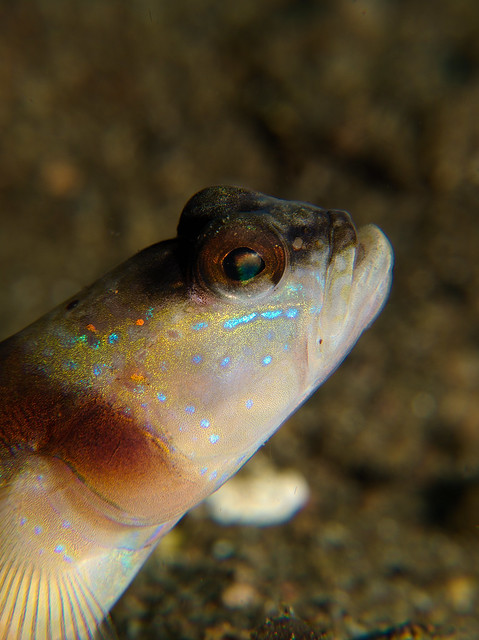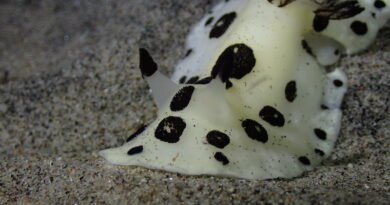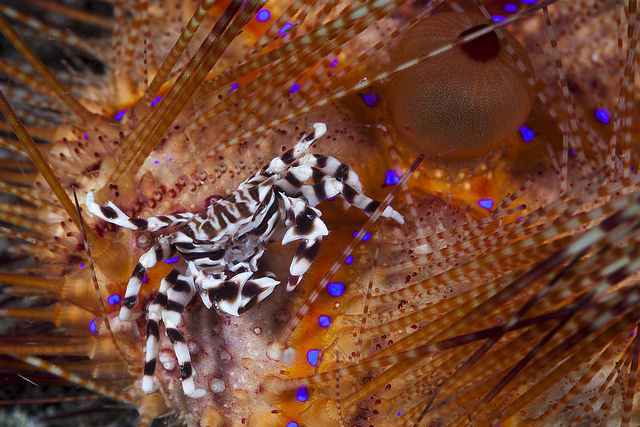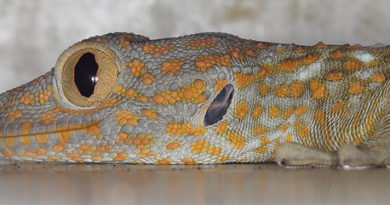What is the Neurobiology of the Shrimp Goby Communication System?
About 120 species of gobies, small marine fishes, live in a mutualistic symbiosis with alpheid shrimp. In this symbiosis, the shrimp digs a burrow which both animal use, and the goby acts as a watchman at the entrance of the burrow. The symbiosis is explained in detail on my Shrimp Goby Page.
One interesting aspect of the symbiosis is the communication system between goby and shrimp. When a predatory fish approaches the burrow entrance fast, the goby escapes into the burrow. This escape reflex is very similar to that of other fishes.
However, when a predatory fish approaches the burrow at a moderate distance or speed, the goby flicks its tail at a fast speed, and the shrimp, in touch with the body of the goby via its antennae, notices that and stays underground. This is a type of “orange alert”, signaling a threat level below the full escape. It’s a piece of information specifically communicated to the shrimp.
The Big Question: How is that communication system implemented in the brain of the goby?
We (that’s my friends and colleagues Joe Landsittel & Bard Ermentrout & myself) recently published a paper with a simulation study which hypothesizes how this could have happened. We use our simulations to explore which kind of system, closely derived from what’s known to be present in brains of “regular” fishes (= non-shrimp-gobies). Which small evolutionary modifications of this base system in the brains of fishes could give rise to a fish which would give rise to a fish which reacts to moderate threats with a “tail flick”.
We started with a model which had been made to describe the zebrafish escape reflex and swimming central pattern generator (CPG).
There is some fancy math which you can either enjoy or skip, but our conclusions are: In the baseline condition, the goby perches. It sits still, and does normally not swim. The swimming central pattern generator is quiet in its baseline condition.
Likely, a novel direct input from the sensory channels of the goby (eyes & ears) reaches the swimming pattern generator. If a moderate stimulus (sight or sound of a somewhat distant dangerous fish) reaches this system, the tail motor neurons are activated, and the goby flicks its tail, hence communicating the danger to the shrimp. This is the evolutionary novelty shrimp gobies came up with.
A strong sensory stimulus (sight or sound of a somewhat distant big fish) still leads to a full blown escape like in most other fishes, this time into the burrow.
Hence, one relatively simple extra neural connection in the shrimp goby can make the communication system happen. The fish brain also contains neurons which would be good candidates for forming such a novel connection, hindbrain neurons similar to the “Mauthner cell”, the escape reflex “Command neuron”.
Here is our paper:
Here you can read the paper online for free.
The proposed neurobiological implementation of the shrimp-goby communication system is also explained in this video, where you can also see some footage of shrimp gobies, and of fish escapes:
Don’t be shy, and contact me if you have any questions & discussion points about this study (my academic email on in the paper).



